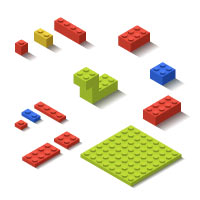Lesson 6: How Often Should a Business Revisit Its IP Strategy?
 A business should revisit its IP strategy as often as it revisits its
corporate strategy — ideally, about once a year.
A business should revisit its IP strategy as often as it revisits its
corporate strategy — ideally, about once a year.
When a business is refreshing its IP strategy, it should repeat the analysis done when it first formulated the strategy, paying close attention to any changes in the company’s position or its products and any changes in the competitive landscape.
One signal that might warrant a reconsideration of a business’s existing IP strategy is a shift in the company’s own IP holdings or portfolio. For example, when a patent expires, the business may have to find other ways to try to maintain its market share.
EXAMPLE: LEGO GROUP (LEGO CO.)

One company that tried some fairly novel approaches after its patents expired is LEGO Group (LEGO Co.), which manufactures the world-famous LEGO brand of children’s interlocking bricks.